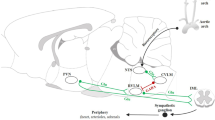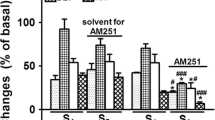Summary
The central nervous system is involved in the control of arterial blood pressure. Stimulation of central α2-adrenoceptors in the nucleus tractus solitarii (NTS) decreases sympathetic outflow, resulting in a fall in arterial blood pressure. One of the first antihypertensive substances with actions on the α2-adrenoceptors of the NTS was α-methylnoradrenaline. Later on the imidazoline clonidine was developed for which numerous effects, mediated by α2-adrenoceptors, in the CNS could be demonstrated. Since the centrally acting α2-adrenoceptor agonists possess severe side effects, the development of more specific and selective centrally acting imidazolines resulted in the derivatives moxonidine and rilmenidine. The effects of the “second-generation imidazolines” could not be fully understood as α2-adrenoceptor agonists. In the meantime, the rostral ventrolateral medulla (RVLM) has been identified as the site of action of the imidazolines and an I1-imidazoline binding site was characterized in this region. For the antihypertensive action of the imidazolines, agonism at the I1-imidazoline subtype seems to be responsible. In addition, an acid- and heat-stable endogenous substance, calledclonidine displacing substance (CDS), was reported to bind at the putative I receptor. In 1992 a receptor protein for I receptors (70 kD) could be separated that is different from that of α2-adrenoceptors. However, up to now we are still lacking the amino-acid sequence of the I receptor and its second messenger system.
Similar content being viewed by others
References
Reis DJ, Morrison S, Ruggiero DA. The C1 area of the brain stem in tonic and reflex control of blood pressure: State of the art lecture.Hypertension 1988;1(Suppl 1):I8-I13.
Palm D, Hellenbrecht D, Quiring K. Pharmakologie noradrenerger und adrenerger Systeme. In: Forth W, Henschler D, Rummel W, Starke K, eds.Allgemeine und spezielle Pharmakologie und Toxikologie. B.I. Wissenschaftsyerlag, 1992;148–199.
Ruffolo RR, Turowski BS, Patil PN. Lack of cross desensitisation between structurally dissimilar α-adrenoceptor agonists.J Pharm Pharmacol Commun 1977;29:378–380.
Starke K. Regulation of noradrenaline release by presynaptic receptor systems.Rev Physiol Biochem Pharmacol 1977;77:1–124.
Bravo EL, Cressman MD, Pohl MA. Cardiovascular and neurohumoral effects of long-term oral clonidine monotherapy in essential hypertensive patients. In: Weber MA, Drayer JIM, Kolloch R, eds.Low Dose Oral and Transdermal Therapy of Hypertension. Darmstadt: Steinhopff, 1985:3.
Kobinger W, Pichler L. Centrally acting drugs (clonidine, methyldopa, guanfacine). In: Ganten D, Mulrow PJ, eds.Pharmacology of Antihypertensive Therapeutics. Berlin: Springer 1990:227–262.
Mosqueda-Garcia R. Guanfacine: A second generation α2-adrenergic blocker.Am J Med Sci 1990;299:73–76.
Weber MA, Graettinger WF, Cheung DG. Centrally acting sympathetic inhibitors. In: Laragh JH, Brenner BM, eds.Hypertension: Pathophysiology, Diagnosis, and Management. New York: Raven Press, 1990:2251–2261.
Ruffolo RR, Rice PJ, Patil PN, Hamada A, Miller DD. Differences in the applicability of the Easson-Stedman hypothesis to the α1 and α2 adrenergic effects of phenylethylamines and imidazolines.Eur J Pharmacol 1983;86:471–475.
Bousquet P, Schwartz J. Alpha-adrenergic drugs: Pharmacological tools for the study of the central nervous system.Biochem Pharmacol 1983;32:1459–1465.
Kobinger W. Central alpha-adrenergic systems as targets for hypotensive drugs.Rev Physiol Biochem Pharmacol 1978;81:39–100.
Sved AF, Tsukamoto K, Schreihofer AM. Stimulation of α2-adrenergic receptors in nucleus tractus solitarius is required for the baroreceptor reflex.Brain Res 1992;576:297–303.
Bousquet P, Feldman J, Schwartz J. Central cardiovascular effects of alpha adrenergic drugs: Differences between catecholamines and imidazolines.J Pharmacol Exp Ther 1984;230:232–236.
Armah BI, Hofferber E, Stenzel W. General pharmacology of the novel centrally acting antihypertensive agent moxonidine.Arzneim Forsch/Drug Res 1988;38:1426–1434.
Haxhiu MA, Dreshaj I, Eriokwu B, et al. Vasodepression elicited in hypertensive rats by the selective I1-imidazoline agonist moxonidine administered into the rostral ventrolateral medulla. In: Schäfer SG, Christen MO, Ernsberger PR, eds.New Perspectives in the Treatment of Hypertension. The Imidazoline Agonist Moxonidine. New York: Raven Press, 1992:21–29.
Ernsberger PR, Westbrooks KL, Christen MO, Schäfer SG. A second generation of centrally acting antihypertensive agents act on putative I1-imidazoline receptors.J Cardiovasc Pharmacol 1992;20(Suppl 4):S1-S10.
Ernsberger PR, Giuliano R, Willette RN, Reis DJ. Role of imidazole receptors in the vasodepressor response to clonidine analogs in the rostral ventrolateral medulla.J Pharmacol Exp Ther 1990;253:408–418.
Ernsberger PR, Damon TH, Graff LM, Schäfer SG, Christen MO. Moxonidine, a centrally acting antihypertensive agent, is a selective ligand for I1-imidazoline sites.J Pharmacol Exp Ther 1993;264:172–182.
Wang H, Regunathan S, Meeley MP, Reis DJ. Isolation of an imidazoline receptor protein. Abstracts of the Council for High Blood Pressure Research 46th Annual Fall Conference and Scientific Sessions, 1992.Hypertension 14/4.
Atlas D, Burstein Y. Isolation of an endogenous clonidine-displacing substance from rat brain.FEBS Lett 1984;170:387–390.
Atlas D, Burstein Y. Isolation and partial purification of a clonidine-displacing endogenous brain substance.Eur J Biochem 1984;144:287–293.
Meeley MP, Ernsberger PR, Granata AR, Reis DJ. An endogenous clonidine-displacing substance from bovine brain: Receptor binding and hypotensive actions in the ventrolateral medulla.Life Sci 1986;38:1119–1126.
Bousquet P, Feldman J, Atlas D. An endogenous, non-catecholamine clonidine antagonist increases mean arterial blood pressure.Eur J Pharmacol 1986;124:167–170.
Atlas D. Clonidine displacing substance (CDS) and its putative imidazoline receptor. New leads for further divergence of α2-adrenergic receptor activity.Biochem Pharmacol 1991;41:1541–1549.
Bricca G, Dontenwill M, Molines A, et al. The imidazoline-preferring receptor: Binding studies in bovine, rat and human brainstem.Eur J Pharmacol 1989;162:1–9.
Ernsberger P, Arango V, Meeley MP, Reis DJ. Selective binding of an endogenous clonidine-like substance to imidazole binding sites and distribution of these sites in the medullar oblongata of the rat.Soc Neurosci Abstr 1986;12:184–190.
Ernsberger P, Giuliano R, Willett RN, et al. Hypotensive action of clonidine analogues correlates with binding affinity at imidazole and not alpha-2-adrenergic receptors in the rostral ventrolateral medulla.J Hypertens 1988;6(Suppl 4):S554-S557.
Author information
Authors and Affiliations
Rights and permissions
About this article
Cite this article
Dominiak, P. Historic aspects in the identification of the I1 receptor and the pharmacology of imidazolines. Cardiovasc Drug Ther 8 (Suppl 1), 21–26 (1994). https://doi.org/10.1007/BF00877081
Issue Date:
DOI: https://doi.org/10.1007/BF00877081




